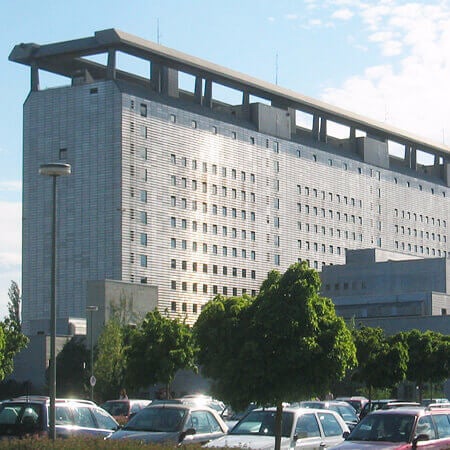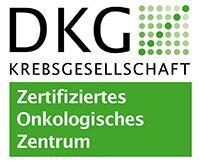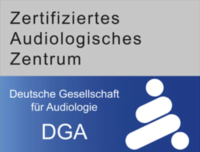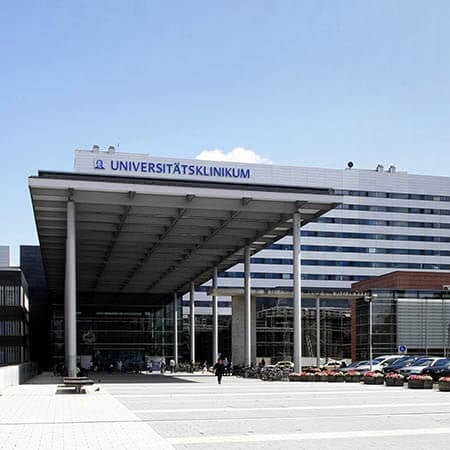The trachea is an essential element of the airways. When the trachea malfunctions, as it does with tracheal cancer, the oxygen level in the human blood decreases, leading to asphyxia and even death of the patient.
Content
- Distinctive features of tracheal tumors
- Tracheal tumor localization
- How to detect tracheal cancer
- The incidence of tracheal cancer in different patients
- How is tracheal cancer treated?
- Innovative treatments for tracheal cancer
- The cost of treatment in Europe
- Organizing treatment in Europe
Distinctive features of tracheal tumors
Tracheal cancer is a highly differentiated malignant disease; i.e. its cells are pretty similar to the normal ones. Hence, its aggressive potential is low, but it is still present. Tracheal tumors grow very slowly, literally for years, but they grow as cancer usually does – intruding into the surrounding tissues and destroying them. Tracheal cancer can metastasize, more often to the lungs, and recurs after removal.
The trachea cannot be replaced by other tissues. Surgical correction is often performed after tumor removal to reduce the severity of postsurgical complications.
Specific tumors – sarcomas – are usually localized near the tracheal bifurcation, where the trachea is divided into two main bronchi. The cancer process can have different aggressiveness depending on the cells prevailing in the sarcomatous tumor. As a rule, sarcomas grow very quickly, but they are sensitive to radiation, and chemotherapy, which is not the case with all the other neoplasms.
Tracheal tumor localization
Tracheal cancer is most often localized in the lower or upper part of the trachea. The tumor can grow from any wall of the organ. The neoplasm can be flat and broad, or it can protrude into the lumen of the trachea. In the second case, the tumor narrows the lumen of the trachea, and in the case of localization over the bifurcation, it can completely block the bronchi.
In airway blockages, patients can die of asphyxia or other complications even before the metastatic process begins. After all, a malignant neoplasm can grow into nearby organs, affecting the esophagus and thyroid gland. In some cases, secondary foci of tumor growth may be found in the paratracheal or cervical lymph nodes and the neck's soft tissues.
At the advanced stages of the disease, distant metastases may be detected in any organ, including the liver, lungs, or heart.
How to detect tracheal cancer
Clinical manifestations usually depend on the degree of cancer spread, the direction of the neoplasm growth, the stage of the disease, the presence or absence of tumor decay, and the size and degree of the tracheal lumen narrowing.
The most common symptoms are breathlessness and coughing. The patient has shortness of breath or wheezing (noisy breathing is caused by severe narrowing of the tracheal lumen). The body usually adapts to gradual tracheal stenosis, so tracheal cancer is often diagnosed late when the narrowing is severe.
Dyspnea appears gradually. At first, it is present only during physical activity, then – even when talking. When bronchitis, influenza, and sputum accumulation join the clinical picture, dyspnea becomes more severe. In the prone position, many patients have attacks of suffocation, due to which they are mistakenly treated for bronchial asthma or bronchitis.
With the severe narrowing of the tracheal lumen, breathing becomes noisy and wheezing, and the pathological process is often joined by pneumonia and bronchitis. In some cases, recurrent pneumonia is the first sign of tracheal cancer.
In addition, many patients complain of a cough that intensifies with a change in body position. The cough is excruciating, persistent, and maybe dry or accompanied by sputum secretion. In some cases, patients even cough up pieces of the tumor, which makes breathing easier.
There is usually no pain. The patient only feels a tightness in the neck or tightness in the chest. The timbre of the voice may change. It can happen because of the compression of alaryngeal nerve or to a tumor growing into it. If the tumor is located at the back of the trachea, there may be pain and difficulty swallowing.
The average duration of the period between the first signs of the disease and the development of the tracheal syndrome listed above is about eight months. Patients have decreased appetite, general weakness, elevated body temperature, and weight loss as the disease progresses.
The incidence of tracheal cancer in different patients
When it comes to the development of tracheal cancer, primary tracheal tumors are sporadic in childhood. Over the last 30 years, no more than 40 tumors have been diagnosed in Europe, about two-thirds of which were benign. Hemangiomas and papillomas are more common in children.
Detection of tracheal cancer in pregnant women is also extremely uncharacteristic. The most vulnerable are older people. The age of the most significant disease incidence is in the 60s. Men are affected more often than women.
The peculiarity of the course of tracheal cancer in elderly patients is the necessity to evaluate the patient's general condition in order to determine the treatment tactics correctly. Generally, not every person can tolerate a surgical intervention and even radiation therapy. Pathological factors that worsen the general condition include concomitant pathologies of the cardiovascular, central nervous system, and complications from surgical interventions.
How is tracheal cancer treated?
The therapy of the disease is complex and includes surgical removal of the neoplasm followed by a course of radiation therapy. During surgical intervention, the doctor removes the neoplasm within healthy tissues. The resulting defects are repaired with plastic surgery. If there is a circular spread, a transverse resection of the trachea with subsequent suturing of its ends is indicated.
The indications for surgery depend on the localization of the neoplasm. The lower it is located, the more difficult it is to perform a surgery. If it is impossible to remove the tumor completely, a palliative operation is performed to reduce the size of the tumor and improve the patient's quality of life. Usually, the surgeon dissects the rings of the trachea, and then removes the tumor or part of it with special instruments. In advanced cases, the tumor is not removed. The surgeon simply dissects the rings of the trachea and inserts a tube through which the patient can breathe.
However, this uncomplicated manipulation can pose health risks to people with tracheal cancer. For example, if the neoplasm occupies a large part of the lumen of the organ, patients breathe through a narrow slit that is formed by a particular position of the head. If a tube is inserted into the trachea, the position will change, and the person can simply suffocate. Therefore, the tube is inserted in a half-sitting position, and the incision is made below the tumor's location. If this is not possible, the surgeon dissects the larynx along the midline, which allows visualization of the lumen size through which the patient is breathing. A long tube is then inserted into the lumen to the bronchi, and then the rest of the manipulation is carried out.
Surgery is useless if the neoplasm has already grown into neighboring organs. In this case, the first-line method of treatment is radiation therapy. Ionizing radiation has a damaging effect on other chest organs, so the dose of radiation is usually limited. As a result, complete tumor regression may not be achieved without chemotherapy being included in the treatment regimen.
In certain cases, external radiation is substituted with brachytherapy, when the radiation source is brought directly to the neoplasm. It allows increasing the total radiation dose with minimal damage to healthy tissues.
Also, radiation therapy is used before surgery to reduce the size of the tumor with subsequent radical removal, and after surgery to prevent a recurrence. Possible side effects of the treatment include radiation-induced esophagitis, tracheitis, and formation of fistulas in the esophagus and trachea. In those patients who undergo treatment in specialized healthcare facilities, such side effects are extremely rare.
Radiotherapy can also be indicated for patients with early stages of cancer. This treatment is often carried out in elderly patients who are not able to tolerate general anesthesia and surgical intervention due to age or concomitant pathology.
Radiotherapy can be complemented by chemotherapy. The chemotherapy treatments aim to prevent the growth of malignant tissue and destroy existing cancer cells. Chemotherapy, which is prescribed when the cancer process is incurable, is called palliative. The drugs are usually given intravenously.
Chemotherapy preparations destroy cancerous cells. In combination with other anticancer methods, chemotherapy gives a positive result in the majority of cases.
Innovative treatments for tracheal cancer
Alternative treatments for tracheal cancer include laser therapy, brachytherapy (which we have already mentioned), cryotherapy, diathermocoagulation, photodynamic therapy, and stenting.
Laser therapy allows the tumor to be resected using laser impact. This treatment is carried out under general anesthesia. The procedure involves using a bronchoscope that is inserted into the trachea to visualize the tumor. This treatment has minimal side effects and allows for quicker discharge from hospitals for patients with tracheal cancer. In the case of early-stage cancer, laser therapy combined with radiotherapy can lead to a cure.
Brachytherapy is actively used to relieve respiratory symptoms of tracheal cancer. During the procedure, a radiation source is inserted into the lumen of the organ. Precise and local irradiation reduces side effects. The procedure is performed during bronchoscopy.
Cryotherapy involves tumor destruction by destroying cancer cells at low temperatures. The procedure is performed under general anesthesia. A cryoprobe is a device that is placed in the trachea during bronchoscopy. Liquid nitrogen is passed through the probe to destroy the affected tissue. The method has few side effects.
Diathermocoagulation is the removal of a tumor with an electric current. This technique is not only therapeutic but can alleviate symptoms of patients with severe and advanced diseases. With the help of a bronchoscope, a probe is applied to the tumor; the tissues are heated with an electric current, and the cancer cells are destroyed.
Photodynamic therapy is treatment with a source of light and photosensitizers – drugs that increase the sensitivity of tissues to light. The medication is injected intravenously. After that, a light source is delivered into the trachea and a treatment session is carried out. After the procedure, the patient may experience short-term side effects, including:
- Shortness of breath
- Coughing
- Swelling and inflammation at the site of the tumor
Airway stenting is the insertion of a special device that dilates the lumen of the trachea. As a result, the patient breathes normally. The method is used as a palliative, in the advanced cases of malignant affection of the trachea.
Some European hospitals have already begun practicing trachea transplantation. Moreover, the trachea can be grown from the patient's own cells, which reduces the risk of immune rejection.
The cost of treatment in Europe
Is the cost of treatment in Europe high? This question worries every person suffering from cancer who has decided to seek medical care in European hospitals. It should be noted that only a doctor who is familiar with the personal medical information of a patient will be able to name exact prices. However, it is possible to calculate the approximate cost of treatment in Europe yourself, if you know the main pricing factors.
One of the main factors is the country where you are going to have treatment. Besides, the prices for medical services depend on the hospital chosen: whether it is private, state, or a part of a multidisciplinary medical center. The number of specialists with a scientific degree working at hospitals also matters. It is the criterion that determines the clinic's level and, accordingly, the cost of treatment in Europe.
On average, prices for diagnostics in European hospitals start at 794 EUR. The cost of treatment with resection and plastic reconstruction is about 10,087 EUR; the cost of treatment with radiotherapy starts from 14,300 EUR; the cost of treatment with one chemotherapy course is about 3,000 EUR. The price for rehabilitation after treatment in European hospitals starts at 950 EUR per day.
You can find more reliable information about the prices for treatment in different countries on the Booking Health website.
Organizing treatment in Europe
Booking Health has been arranging tracheal cancer treatment in the best European hospitals for over 12 years. We are not afraid of the most complex cases; find the best hospitals and specialists, and take care of everything before, during, and after treatment of tracheal cancer.
You can choose your clinic and doctor on your own or follow the advice of our experts.
Booking Health translates your medical reports and helps you find the best tracheal cancer treatment options. Once decided upon the treatment program, Booking Health arranges your trip from A to Z – taking care of the communication with the clinic; assistance in obtaining a treatment invitation and visa, interpreter, and transfers.
If you need more information, please, leave a request on the Booking Health website, and a medical advisor will contact you as soon as possible.
Authors:
The article was edited by medical experts, board certified doctors Dr. Nadezhda Ivanisova and Dr. Sergey Pashchenko. For the treatment of the conditions referred to in the article, you must consult a doctor; the information in the article is not intended for self-medication!
Sources:
European Society for Medical Oncology
Verywell Health
Cancer Research Institute




















